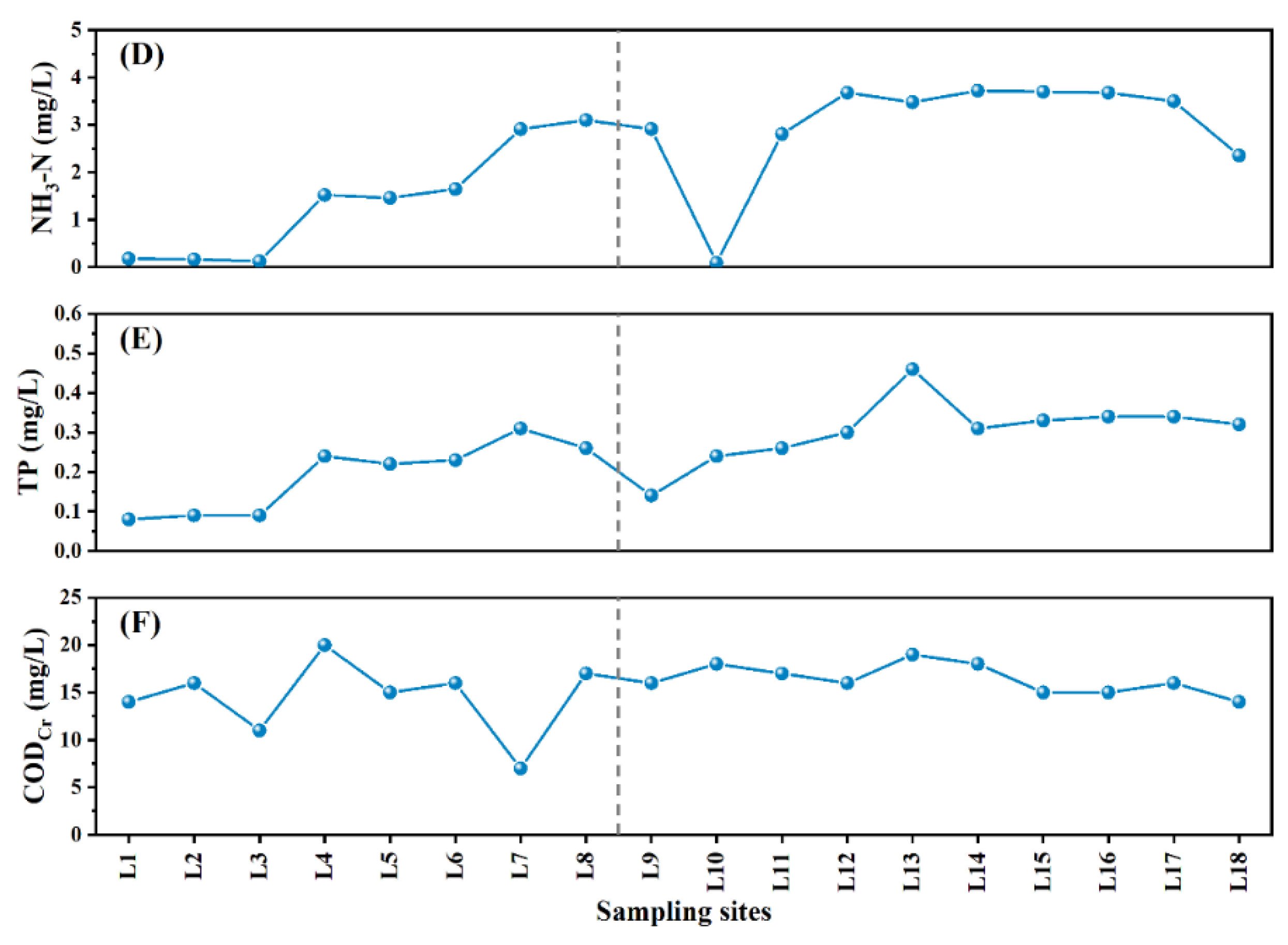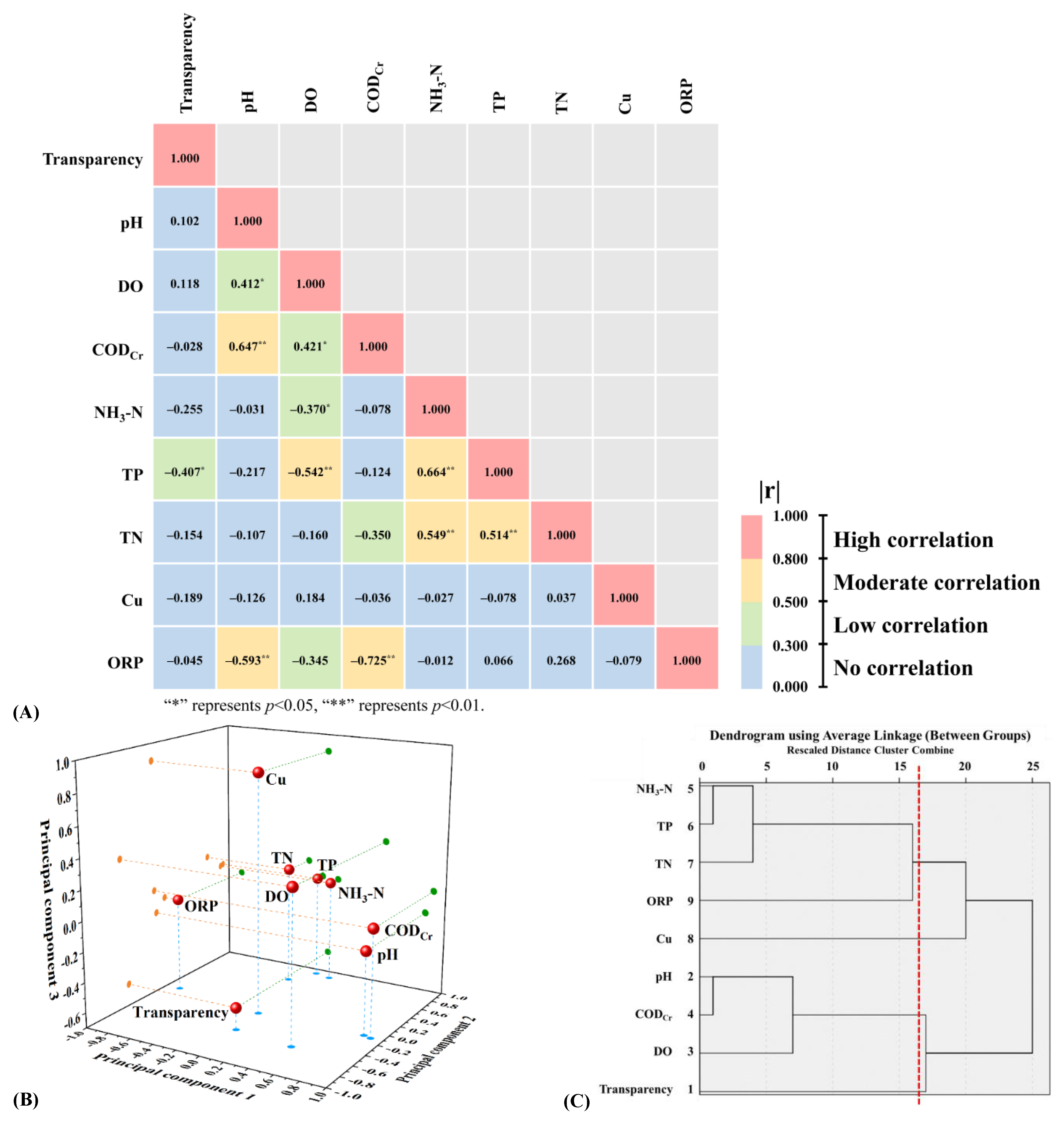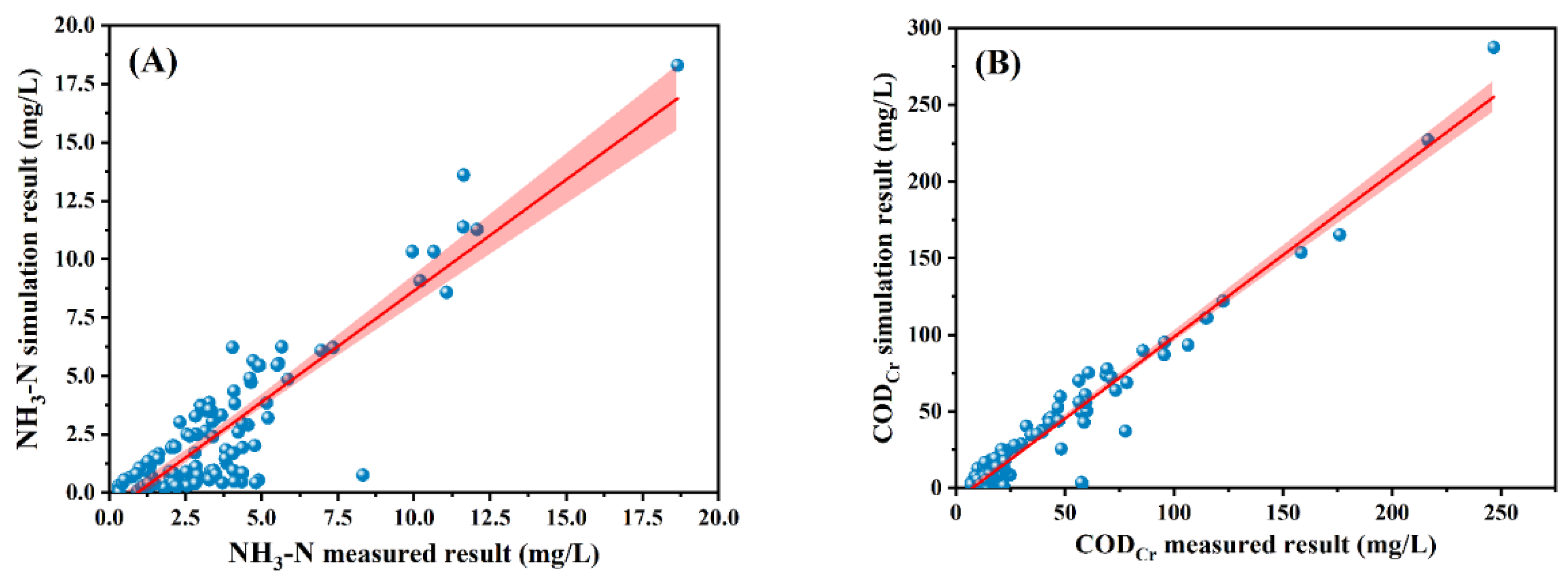A Multi-Dimensional Investigation on Water Quality of Urban Rivers with Emphasis on Implications for the Optimization of Monitoring Strategy
Abstract
:1. Introduction
2. Materials and Methods
2.1. Study Area
2.2. Water Sampling and Chemical Analysis
2.3. Monitoring Objects
2.3.1. Single Factor (SF)
2.3.2. Comprehensive Pollution Index (CPI)
2.3.3. Water Quality Identification Index (WQII)
2.3.4. Water Quality Level Index (WQLI)
2.3.5. Analytical Hierarchy Process (AHP)
2.4. Monitoring Parameters
2.5. Monitoring Frequency
3. Results and Discussion
3.1. Distribution of Pollutants in the Shili River and the Lianxi River
3.2. Results of Monitoring Objects
3.3. Results of Monitoring Parameters
3.4. Results of Monitoring Frequency
4. Conclusions
Supplementary Materials
Author Contributions
Funding
Institutional Review Board Statement
Informed Consent Statement
Data Availability Statement
Acknowledgments
Conflicts of Interest
References
- Hobbie, S.E.; Finlay, J.C.; Janke, B.D.; Nidzgorski, D.A.; Millet, D.B.; Baker, L.A. Contrasting nitrogen and phosphorus budgets in urban watersheds and implications for managing urban water pollution. Proc. Nat. Acad. Sci. USA 2017, 114, 4177–4182. [Google Scholar] [CrossRef] [PubMed] [Green Version]
- Puckett, L.J. Identifying the major sources of nutrient water pollution. Environ. Sci. Technol. 1995, 29, 408A–414A. [Google Scholar] [CrossRef]
- Xia, J.; Zhang, Y.; Xiong, L.; He, S.; Wang, L.; Yu, Z. Opportunities and challenges of the Sponge City construction related to urban water issues in China. Sci. China Earth Sci. 2017, 60, 652–658. [Google Scholar] [CrossRef]
- Wang, H.; Wu, M.; Deng, Y.; Tang, C.; Yang, R. Surface water quality monitoring site optimization for Poyang Lake, the largest freshwater lake in China. Int. J. Environ. Res. Public Health 2014, 11, 11833–11845. [Google Scholar] [CrossRef] [PubMed] [Green Version]
- Mantzafleri, N.; Psilovikos, A.; Blanta, A. Water quality monitoring and modeling in Lake Kastoria, using GIS. Assessment and management of pollution sources. Water Resour. Manage. 2009, 23, 3221–3254. [Google Scholar] [CrossRef]
- Ahuja, S. Monitoring Water Quality: Pollution Assessment, Analysis, and Remediation; Elsevier: Amsterdam, The Netherlands, 2013. [Google Scholar]
- Guzinski, R.; Kass, S.; Huber, S.; Bauer-Gottwein, P.; Jensen, I.H.; Naeimi, V.; Doubkova, M.; Walli, A.; Tottrup, C. Enabling the use of earth observation data for integrated water resource management in Africa with the water observation and information system. Remote Sens. 2014, 6, 7819–7839. [Google Scholar] [CrossRef] [Green Version]
- Yu, W.; Ma, L. External government performance evaluation in China: Evaluating the evaluations. Public Perform. Manage. 2015, 39, 144–171. [Google Scholar] [CrossRef]
- Canter, L.W. River Water Quality Monitoring; CRC Press: Boca Raton, FL, USA, 1985. [Google Scholar]
- Bartram, J.; Ballance, R. Water Quality Monitoring: A Practical Guide to the Design and Implementation of Freshwater Quality Studies and Monitoring Programmes; CRC Press: Boca Raton, FL, USA, 1996. [Google Scholar]
- Gray, N. Water technology: An introduction for environmental scientists and engineers, 3rd ed.; Taylor & Francis: Oxford, UK, 2010. [Google Scholar]
- Dong, J.; Wang, G.; Yan, H.; Xu, J.; Zhang, X. A survey of smart water quality monitoring system. Environ. Sci. Pollut. Res. 2015, 22, 4893–4906. [Google Scholar] [CrossRef]
- Behmel, S.; Damour, M.; Ludwig, R.; Rodriguez, M.J. Water quality monitoring strategies—a review and future perspectives. Sci. Total Environ. 2016, 571, 1312–1329. [Google Scholar] [CrossRef] [PubMed]
- Geological Survey (US); Office of Water Data Coordination. National Handbook of Recommended Methods for Water-Data Acquisition; US Government Printing Office: Reston, VA, USA, 1977.
- Ouyang, Y. Evaluation of river water quality monitoring stations by principal component analysis. Water Res. 2005, 39, 2621–2635. [Google Scholar] [CrossRef]
- Khalil, B.; Ouarda, T.B.M.J.; St-Hilaire, A.; Chebana, F. A statistical approach for the rationalization of water quality indicators in surface water quality monitoring networks. J. Hydrol. 2010, 386, 173–185. [Google Scholar] [CrossRef]
- Karamouz, M.; Kerachian, R.; Akhbari, M.; Hafez, B. Design of river water quality monitoring networks: A case study. Environ. Model Assess. 2008, 14, 705. [Google Scholar] [CrossRef]
- Chen, K.; Chen, H.; Zhou, C.; Huang, Y.; Qi, X.; Shen, R.; Liu, F.; Zuo, M.; Zou, X.; Wang, J.; et al. Comparative analysis of surface water quality prediction performance and identification of key water parameters using different machine learning models based on big data. Water Res. 2020, 171, 115454. [Google Scholar] [CrossRef] [PubMed]
- Jeung, M.; Baek, S.; Beom, J.; Cho, K.H.; Her, Y.; Yoon, K. Evaluation of random forest and regression tree methods for estimation of mass first flush ratio in urban catchments. J. Hydrol. 2019, 575, 1099–1110. [Google Scholar] [CrossRef]
- Wang, F.; Wang, Y.; Zhang, K.; Hu, M.; Weng, Q.; Zhang, H. Spatial heterogeneity modeling of water quality based on random forest regression and model interpretation. Environ. Res. 2021, 202, 111660. [Google Scholar] [CrossRef] [PubMed]
- Qiu, J. Yangtze finless porpoises in peril. Nature 2012. [Google Scholar] [CrossRef]
- Yang, W.; Zhao, Y.; Wang, D.; Wu, H.; Lin, A.; He, L. Using principal components analysis and IDW interpolation to determine spatial and temporal changes of surface water quality of Xin’anjiang River in Huangshan, China. Int. J. Environ. Res. Public Health 2020, 17, 2942. [Google Scholar] [CrossRef] [PubMed]
- Xu, Z.; Xu, J.; Yin, H.; Jin, W.; Li, H.; He, Z. Urban river pollution control in developing countries. Nat. Sustain. 2019, 2, 158–160. [Google Scholar] [CrossRef]
- Vásquez, C.; Calva, J.; Morocho, R.; Donoso, D.A.; Benítez, Á. Bryophyte communities along a tropical urban river respond to heavy metal and arsenic pollution. Water 2019, 11, 813. [Google Scholar] [CrossRef] [Green Version]
- Ouattara, N.K.; Garcia-Armisen, T.; Anzil, A.; Brion, N.; Servais, P. Impact of wastewater release on the faecal contamination of a small urban river: The Zenne River in Brussels (Belgium). Water Air Soil. Pollut. 2014, 225, 2043. [Google Scholar] [CrossRef]
- Riechel, M.; Matzinger, A.; Pawlowsky-Reusing, E.; Sonnenberg, H.; Uldack, M.; Heinzmann, B.; Caradot, N.; Seggern, D. Impacts of combined sewer overflows on a large urban river–understanding the effect of different management strategies. Water Res. 2016, 105, 264–273. [Google Scholar] [CrossRef] [PubMed]
- Ministry of Ecology and Environment of the People’s Republic of China. Technical Specifications Requirements for Monitoring of Surface Water and Waste Water (HJ/T 91—2002); China Environmental Science Press: Beijing, China, 2002. (In Chinese)
- Ministry of Ecology and Environment of the People’s Republic of China. Methods of Analysis for Water and Wastewater Monitoring, 4th ed.; China Environmental Science Press: Beijing, China, 2002. (In Chinese)
- Chinese Government Procurement. The First Phase of the Comprehensive Treatment of the Water Environment System in the Downtown Area of Jiujiang—PPP Project Contract. Available online: http://www.ccgp.gov.cn/cggg/dfgg/qtgg/201901/t20190107_11475588.htm (accessed on 2 March 2022). (In Chinese)
- Murphy, J.; Riley, J.P. A modified single solution method for the determination of phosphate in natural waters. Anal. Chim. Acta 1962, 27, 31–36. [Google Scholar] [CrossRef]
- Ji, X.; Liu, C.; Pan, G. Interfacial oxygen nanobubbles reduce methylmercury production ability of sediments in eutrophic waters. Ecotox. Environ. Safe. 2020, 188, 109888. [Google Scholar] [CrossRef] [PubMed]
- American Public Health Association; American Water Works Association; Water Environment Federation. Standard Methods for the Examination of Water and Wastewater, 20th ed.; Clesceri, L.S., Greenberg, A.E., Eaton, A.D., Eds.; American Public Health Association: Washington, DC, USA, 1999. [Google Scholar]
- Ren, J.; Li, N.; Wei, H.; Li, A.; Yang, H. Efficient removal of phosphorus from turbid water using chemical sedimentation by FeCl3 in conjunction with a starch-based flocculant. Water Res. 2020, 170, 115361. [Google Scholar] [CrossRef] [PubMed]
- Ministry of Ecology and Environment of the People’s Republic of China. Water Quality—Determination of Total Phosphorus—Ammonium Molybdate Spectrophotometric Method (GB/T 11893—1989); China Environmental Science Press: Beijing, China, 1989. (In Chinese)
- Ministry of Ecology and Environment of the People’s Republic of China. Water Quality—Determination of Ammonia Nitrogen—Nessler’s Reagent Spectrophotometry (HJ 535—2009); China Environmental Science Press: Beijing, China, 2009. (In Chinese)
- Ministry of Ecology and Environment of the People’s Republic of China. Water Quality—Determination of the Chemical Oxygen Demand—Dichromate Method (HJ 828—2017); China Environmental Science Press: Beijing, China, 2017. (In Chinese)
- Ministry of Ecology and Environment of the People’s Republic of China; General Administration of Quality Supervision, Inspection and Quarantine of the People’s Republic of China. Environmental Quality Standards for Surface Water (GB 3838—2002); China Environmental Science Press: Beijing, China, 2002. (In Chinese)
- Brady, J.P.; Ayoko, G.A.; Martens, W.N.; Goonetilleke, A. Development of a hybrid pollution index for heavy metals in marine and estuarine sediments. Environ. Monit. Assess. 2015, 187, 306. [Google Scholar] [CrossRef] [PubMed] [Green Version]
- Xu, Z. Comprehensive water quality identification index for environmental quality assessment of surface water. J. Tongji Univ. (Nat. Sci.) 2005, 33, 482–488. (In Chinese) [Google Scholar]
- Deng, J. Water Quality Level Index (WLI) and its application in water quality assessment and early warning in coastal areas of southern Guangxi. Yangtze River 2021, 52, 18–24. (In Chinese) [Google Scholar]
- Karimi, A.R.; Mehrdadi, N.; Hashemian, S.J.; Bidhendi, G.R.N.; Moghaddam, R.T. Selection of wastewater treatment process based on the analytical hierarchy process and fuzzy analytical hierarchy process methods. Int. J. Environ. Sci. Technol. 2011, 8, 267–280. [Google Scholar] [CrossRef] [Green Version]
- Saaty, T.L. The Analytic Hierarchy Process; Mcgrew-Hill: New York, NY, USA, 1980. [Google Scholar]
- Jiujiang Ecological Environment Bureau. Monitoring Data of Black and Odorous Water Bodies in Urban Built-Up Areas of Jiujiang City. Available online: http://sthjj.jiujiang.gov.cn/zwgk_215/zdly/hjzljc/hjzkgb/ (accessed on 2 March 2022). (In Chinese)
- Lu, C.; Xu, Z.; Dong, B.; Zhang, Y.; Wang, M.; Zeng, Y.; Zhang, C. Machine learning for the prediction of heavy metal removal by chitosan-based flocculants. Carbohyd. Polym. 2022, 285, 119240. [Google Scholar] [CrossRef]
- Breiman, L. Random Forests. Mach. Learn. 2001, 45, 5–32. [Google Scholar] [CrossRef] [Green Version]
- Been, F.; Rossi, L.; Ort, C.; Rudaz, S.; Delémont, O.; Esseiva, P. Population normalization with ammonium in wastewater-based epidemiology: Application to illicit drug monitoring. Environ. Sci. Technol. 2014, 48, 8162–8169. [Google Scholar] [CrossRef] [PubMed]
- Zheng, Q.D.; Lin, J.G.; Pei, W.; Guo, M.X.; Wang, Z.; Wang, D.G. Estimating nicotine consumption in eight cities using sewage epidemiology based on ammonia nitrogen equivalent population. Sci. Total Environ. 2017, 590–591, 226–232. [Google Scholar] [CrossRef] [PubMed]
- Huang, D.; Liu, X.; Jiang, S.; Wang, H.; Wang, J.; Zhang, Y. Current state and future perspectives of sewer networks in urban China. Front. Environ. Sci. Eng. 2018, 12, 2. [Google Scholar] [CrossRef]
- Jarvie, H.P.; Neal, C.; Withers, P.J.A. Sewage-effluent phosphorus: A greater risk to river eutrophication than agricultural phosphorus? Sci. Total Environ. 2006, 360, 246–253. [Google Scholar] [CrossRef]
- Adimalla, N. Application of the Entropy weighted water quality index (EWQI) and the pollution index of groundwater (PIG) to assess groundwater quality for drinking purposes: A case study in a rural area of Telangana State, India. Arch. Environ. Con. Tox. 2021, 80, 31–40. [Google Scholar] [CrossRef] [PubMed]
- Yin, H.L.; Xu, Z.X. Comparative study on typical river comprehensive water quality assessment methods. Resour. Environ. Yangtze Basin 2008, 17, 729–733. (In Chinese) [Google Scholar]
- Minh, H.V.T.; Avtar, R.; Kumar, P.; Tran, D.Q.; Ty, T.V.; Behera, H.C.; Kurasaki, M. Groundwater quality assessment using fuzzy-AHP in An Giang Province of Vietnam. Geosciences 2019, 9, 330. [Google Scholar] [CrossRef] [Green Version]
- Meyer, A.M.; Klein, C.; Fünfrocken, E.; Kautenburger, R.; Beck, H.P. Real-time monitoring of water quality to identify pollution pathways in small and middle scale rivers. Sci. Total Environ. 2019, 651, 2323–2333. [Google Scholar] [CrossRef] [PubMed]
- Putri, M.S.A.; Lou, C.H.; Syai’in, M.; Ou, S.H.; Wang, Y.C. Long-term river water quality trends and pollution source apportionment in Taiwan. Water 2018, 10, 1394. [Google Scholar] [CrossRef] [Green Version]
- Duan, W.; He, B.; Nover, D.; Yang, G.; Chen, W.; Meng, H.; Zou, S.; Liu, C. Water quality assessment and pollution source identification of the eastern Poyang Lake basin using multivariate statistical methods. Sustainability 2016, 8, 133. [Google Scholar] [CrossRef] [Green Version]
- Melchiors, M.S.; Piovesan, M.; Becegato, V.R.; Becegato, V.A.; Tambourgi, E.B.; Paulino, A.T. Treatment of wastewater from the dairy industry using electroflocculation and solid whey recovery. J. Environ. Manage. 2016, 182, 574–580. [Google Scholar] [CrossRef]
- Xu, Z.; Wang, L.; Yin, H.; Li, H.; Schwegler, B.R. Source apportionment of non-storm water entries into storm drains using marker species: Modeling approach and verification. Ecol. Indic. 2016, 61, 546–557. [Google Scholar] [CrossRef]
- Beckers, L.M.; Brack, W.; Dann, J.P.; Krauss, M.; Müller, E.; Schulze, T. Unraveling longitudinal pollution patterns of organic micropollutants in a river by non-target screening and cluster analysis. Sci. Total Environ. 2020, 727, 138388. [Google Scholar] [CrossRef]
- Yang, L.; Li, J.; Zhou, K.; Feng, P.; Dong, L. The effects of surface pollution on urban river water quality under rainfall events in Wuqing district, Tianjin, China. J. Clean. Prod. 2021, 293, 126136. [Google Scholar] [CrossRef]
- Xu, Z.; Xiong, L.; Li, H.; Liao, Z.; Yin, H.; Wu, J.; Xu, J.; Chen, H. Influences of rainfall variables and antecedent discharge on urban effluent concentrations and loads in wet weather. Water Sci. Technol. 2017, 75, 1584–1598. [Google Scholar] [CrossRef] [Green Version]
- Walsh, C.J.; Roy, A.H.; Feminella, J.W.; Cottingham, P.D.; Groffman, P.M.; Morgan, R.P. The urban stream syndrome: Current knowledge and the search for a cure. J. N. Am. Benthol. Soc. 2005, 24, 706–723. [Google Scholar] [CrossRef]
- Hiki, K.; Nakajima, F.; Tobino, T. Causes of highway road dust toxicity to an estuarine amphipod: Evaluating the effects of nicotine. Chemosphere 2017, 168, 1365–1374. [Google Scholar] [CrossRef] [PubMed]
- Kay, P.; Hughes, S.R.; Ault, J.R.; Ashcroft, A.E.; Brown, L.E. Widespread, routine occurrence of pharmaceuticals in sewage effluent, combined sewer overflows and receiving waters. Environ. Pollut. 2017, 220, 1447–1455. [Google Scholar] [CrossRef] [Green Version]
- Peng, H.Q.; Liu, Y.; Wang, H.W.; Gao, X.L.; Ma, L.M. Event mean concentration and first flush effect from different drainage systems and functional areas during storms. Environ. Sci. Pollut. Res. 2016, 23, 5390–5398. [Google Scholar] [CrossRef]
- Li, T.; Tan, Q.; Zhu, S. Characteristics of combined sewer overflows in Shanghai and selection of drainage systems. Water Environ. J. 2010, 24, 74–82. [Google Scholar] [CrossRef]
- Liu, P.; Wang, J.; Sangaiah, A.K.; Xie, Y.; Yin, X. Analysis and prediction of water quality using LSTM deep neural networks in IoT environment. Sustainability 2019, 11, 2058. [Google Scholar] [CrossRef] [Green Version]








| Parameter | Limit Concentration (mg/L) | |
|---|---|---|
| Southern Section | Northern Section | |
| NH3-N | 1.5 | 2.0 |
| TP | 0.3 | |
| CODCr | 30 | |
| Quality of Water | Single Factor (SF) | Comprehensive Pollution Index (CPI) | Water Quality Identification Index (WQII) | Water Quality Level Index (WQLI) | |
|---|---|---|---|---|---|
| Mean Pollution Index (MPI) | Nemerow Pollution Index (NPI) | ||||
| Unpolluted | |||||
| Slightly polluted | |||||
| Moderately polluted | |||||
| Polluted | |||||
| Strongly polluted | |||||
| Extremely polluted | |||||
| Water Quality | SF | MPI | NPI | WQII | WQLI | ||||||
|---|---|---|---|---|---|---|---|---|---|---|---|
| TP | NH3-N | CODCr | TP | NH3-N | CODCr | TP | NH3-N | CODCr | |||
| Unpolluted | S1–S19, S21, L1–L6, L8–L12 | S1–S17, S20–S28, L1–L5, L10 | S1–S4, S6–S28, L1–L18 | S3–S4, S6 | S1–S17, S21, S27–S28, L1–L6, L10 | S27 | S3, S5–S7, S10, S22–S23, S27–S28, L2–L3, L10 | S1–S4, S6–S18, S24–S25, S27–S28, L1, L3, L5, L7, L15, L16, L18 | S27 | S3, S5–S7, S10, S22–S23, S27–S28, L3, L10 | S1–S4, S6–S18, S24–S25, S27–S28, L1, L3, L5, L7, L15–L16, L18 |
| Slightly polluted | S20, S22–S26, L7, L13–L18 | S18, S19, L4, L6–L9, L11–L18 | S5 | S1–S2, S5, S7–S15, L1–L3 | S18–S20, S22–S24, S26, L7–L9, L11–L18 | S1–S9, S11–S15, S17, S28, L1–L3 | S1–S2, S4, S8–S9, S13, S20, L1 | / | S1–S9, S11–S15, S17, S28, L1–L3 | S1–S2, S4, S8–S9, S13, S20, L1–L2 | / |
| Moderately polluted | S16–S17, S20, S22, L10 | S26 | S10, S16, L9 | S11–S12, S14–S15, S25–S26 | S19–S23, S26, L2, L4, L6, L8–L14, L17 | S10, S16, L9 | S11–S12, S14–S15, S25–S26 | S19–S23, S26, L2, L4, L6, L8–L14, L17 | |||
| Polluted | S18, S21, S23, S26; L4–L6, L9, L11, L18 | S18–S19, S21, L4–L6, L8, L10–L12 | S16, S21, S24, L4–L5 | / | S18–S19, S21, L4–L6, L8, L10–L12 | S16, S21, S24, L5 | / | ||||
| Strongly polluted | S19, S24–S25, L7–L8, L12–L17 | / | S20, S22, L7, L14–L18 | S17, L6 | S5 | S20, S22, L7, L14–L18 | S17, L4, L6 | S5 | |||
| Extremely polluted | / | / | S23–S26, L13 | S18–S19, L7–L9, L11–L18 | / | S23–S26, L13 | S18–S19, L7–L9, L11–L18 | / | |||
Publisher’s Note: MDPI stays neutral with regard to jurisdictional claims in published maps and institutional affiliations. |
© 2022 by the authors. Licensee MDPI, Basel, Switzerland. This article is an open access article distributed under the terms and conditions of the Creative Commons Attribution (CC BY) license (https://creativecommons.org/licenses/by/4.0/).
Share and Cite
Ji, X.; Chen, J.; Guo, Y. A Multi-Dimensional Investigation on Water Quality of Urban Rivers with Emphasis on Implications for the Optimization of Monitoring Strategy. Sustainability 2022, 14, 4174. https://doi.org/10.3390/su14074174
Ji X, Chen J, Guo Y. A Multi-Dimensional Investigation on Water Quality of Urban Rivers with Emphasis on Implications for the Optimization of Monitoring Strategy. Sustainability. 2022; 14(7):4174. https://doi.org/10.3390/su14074174
Chicago/Turabian StyleJi, Xiaonan, Jianghai Chen, and Yali Guo. 2022. "A Multi-Dimensional Investigation on Water Quality of Urban Rivers with Emphasis on Implications for the Optimization of Monitoring Strategy" Sustainability 14, no. 7: 4174. https://doi.org/10.3390/su14074174
APA StyleJi, X., Chen, J., & Guo, Y. (2022). A Multi-Dimensional Investigation on Water Quality of Urban Rivers with Emphasis on Implications for the Optimization of Monitoring Strategy. Sustainability, 14(7), 4174. https://doi.org/10.3390/su14074174





